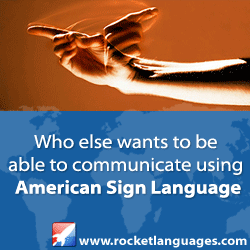American Sign Language Lessons
0Learning a second language is a wonderful way to open your mind to new ways of thinking. Not only are you learning to communicate in another language, you are also learning about the people and culture. This can help widen your net of empathy for people different than you.
American Sign Language (as well as other sign languages) is unique among languages because it doesn’t utilize any vocal cues. Instead, it relies on body language, gestures, and facial expressions.
You may be surprised by what can you can say without even opening your mouth or writing down your words.
Learning the Basics of American Sign Language
As is the case with most language lessons, things are going to start out pretty basic. Think signs such as hello, please, and thank you. Depending the on the learned vocabulary, you may even begin to string signs together into sentences and conversations. So, basic grammar, too.
As you progress through your beginners lessons on American Sign Language, you will likely cover some, or all, of the following subjects:
- Letter spelling (the alphabet used with ASL)
- Time keeping numbers (minutes, hours, days of the week, months, etc.)
- Food and food related signs (dinner, cooking, eat, prepare, etc.)
- Family and friends (parents, baby, girl, related, etc.)
- Businesses and money (cost, store, shop, pay, etc.)
- Animals and animal care (monkey, dog, cat, leash, etc.)
- Colors (red, clear, rainbow, etc.)
- Assorted other common words (yes, deaf, hear, name, etc.)
As well as learning various signs, you will also begin get a feel for deaf culture. This includes things such as the etiquette, values, beliefs, and so on.
You will also learn that the deaf community is not strictly people who are deaf. It also includes people who are hard of hearing.
There are numerous resources you can utilize when you are beginning to learn ASL. One such resource are the lessons put out by Rocket Languages.
Learning American Sign Language for Kids
The American Sign Language Lessons for kids are going to be similar to the vocabulary list seen in other lower-level lessons.
One noticeable different would probably be more of a focus on school and school-related signs. This would replace vocabulary for things like business and money that would be found in an adult beginners’ class.
Teaching a kid American Sign Language—or any second language, really—is very beneficial. People tend to be more receptive to learning a second language when they are younger. And “younger” can mean as young as only a few months old.
At this age, signs for “more”, “please”, and “thank you” can easily be taught when feeding a baby. When the baby is hungry, they can sign “more” and “please.” “Thank you” can be signed when they receive something they want.
By enhancing their overall verbal and non-verbal understanding at a young age, parents can help their kids grow up bilingual. This can help to open doors as the kid grows up.
Where to Take American Sign Language Lessons
As far as where to take ASL lessons, you have a few options:
Online
Online lessons, like those found on the Rocket Languages website, offer you a lot of flexibility. Not only can you work on them whenever you have the free time, you can also work at your own pace. Another nice thing about online lessons is that you can do them comfortably at home.
A Local Community Center
Sometimes these lessons are free. Sometimes there is a small fee.
They are a good face-to-face way to learn ASL. They also provide you with support from your community. This is great for practicing and for getting to know you neighbors a little better.
Academic Classes
Classes in ASL can be found from pre-school to higher education. These classes are commonly taken by people who can hear fine (this is fantastic!), but there may also be individuals who are audibly impaired.
Take note, too, that there are entire schools geared toward teaching the audibly impaired ASL and about the deaf community.
Conclusion
You should start learning American Sign Language now. There are so many benefits. You may even improve your hand-eye coordination.
Learning ASL doesn’t have to be a solitary journey, either. You can practice with friends, your significant other, your kids, other even other people in your community.
By better understanding each other, by optimizing the channels of communication, people have more freedom over the expression of their thoughts and ideas.

